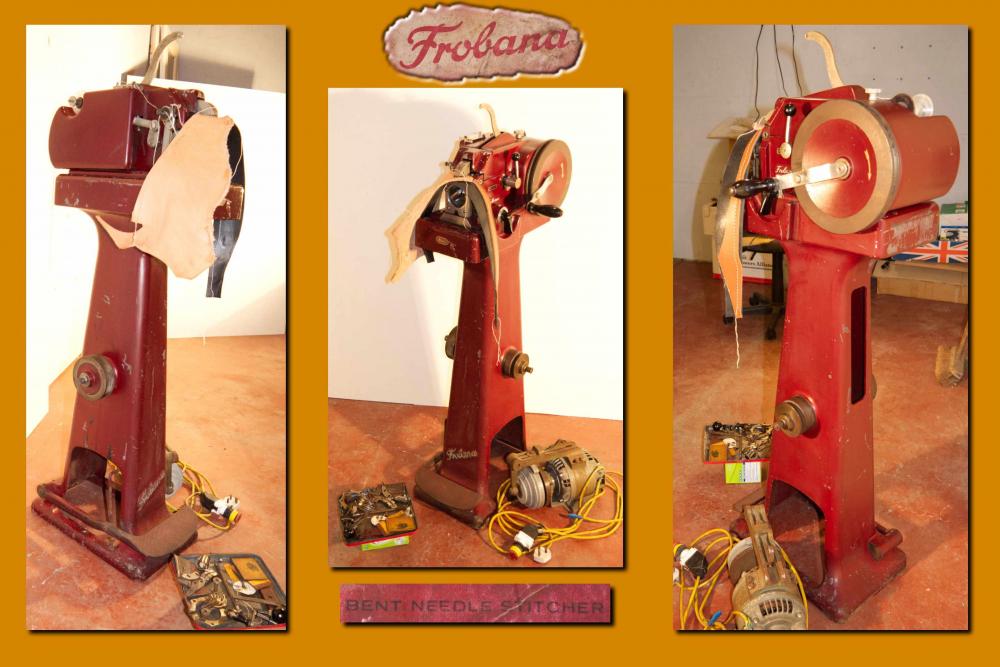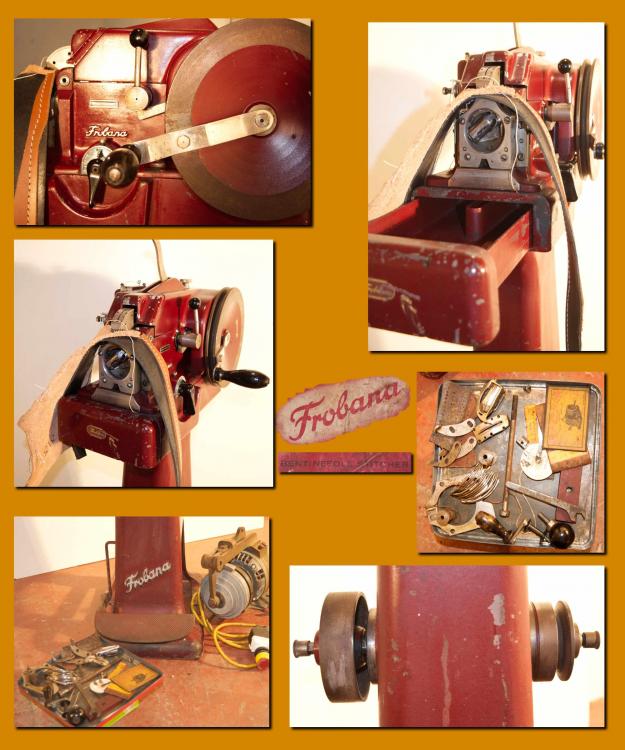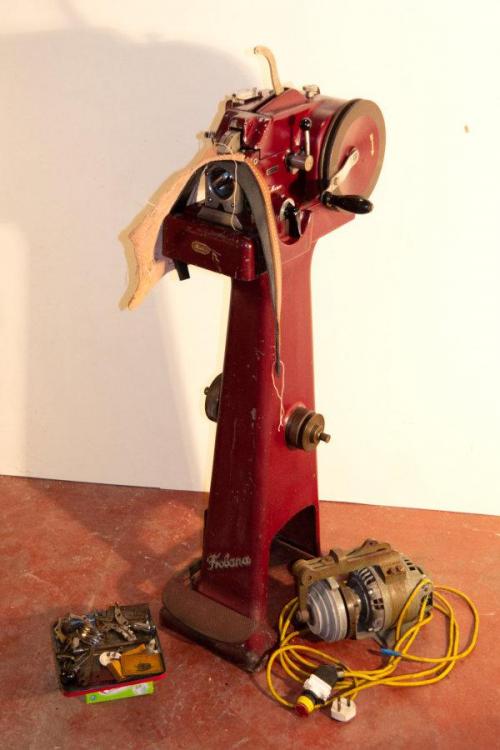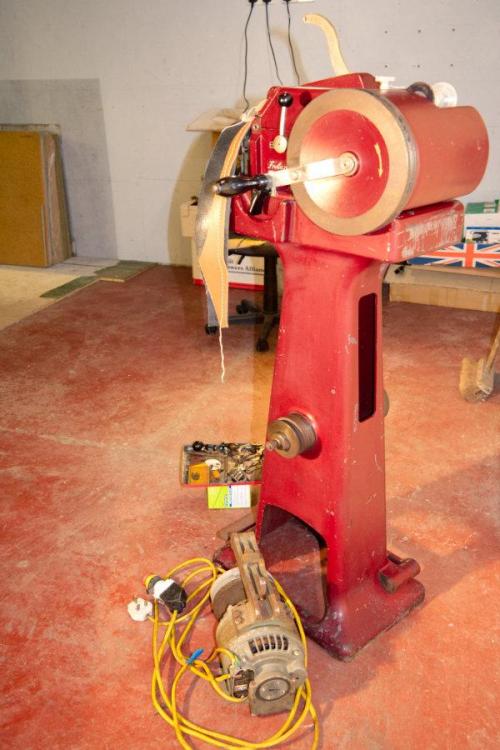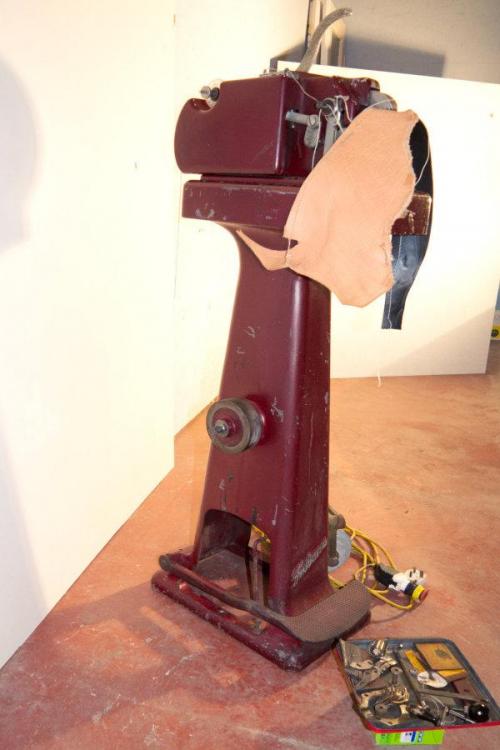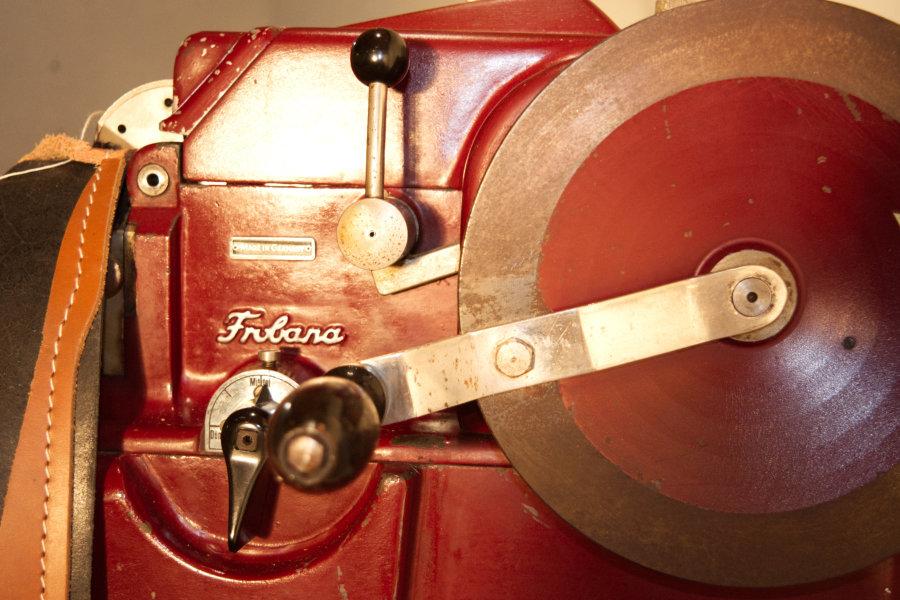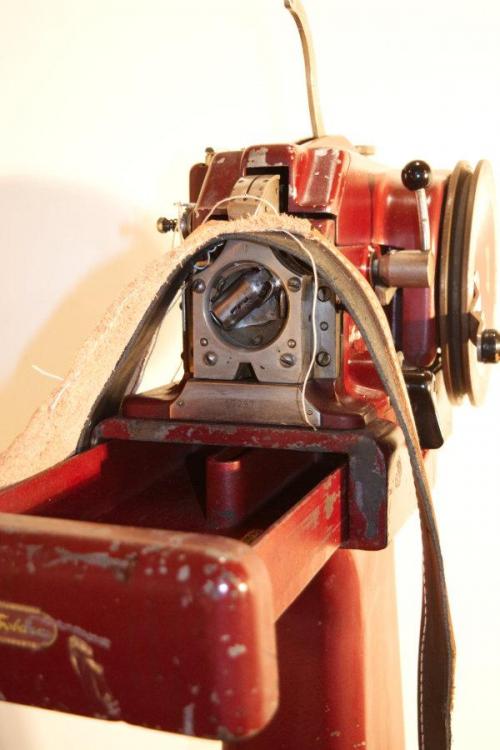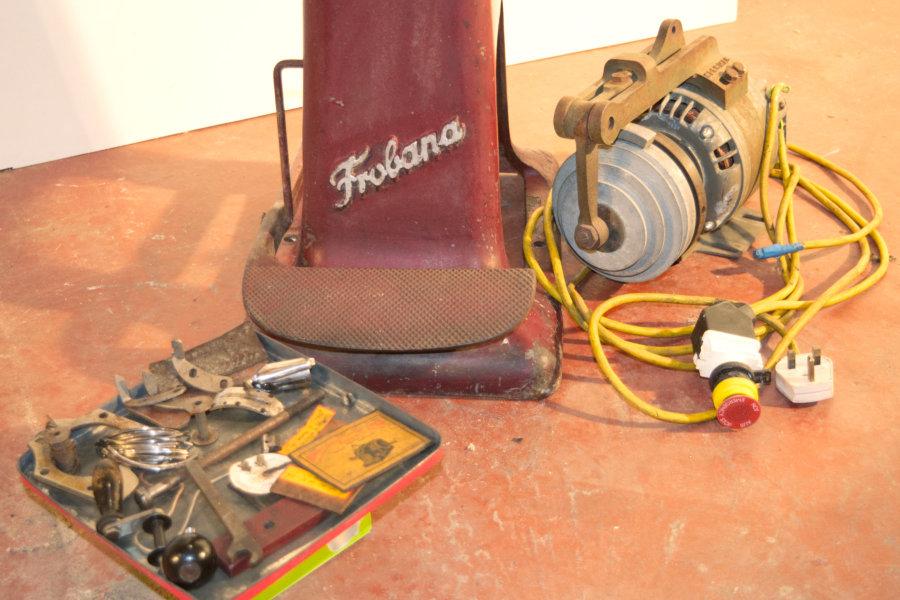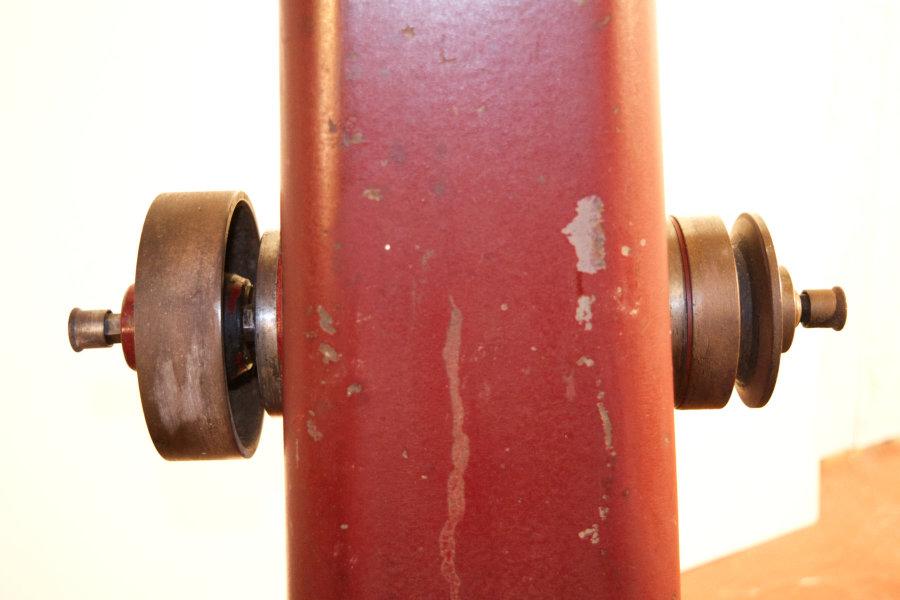-
Posts
105 -
Joined
-
Last visited
About HENDREFORGAN
- Birthday 02/10/1954
Profile Information
-
Gender
Male
-
Location
Pembrokeshire, Cymru, UK.
-
Interests
Adult Leather-gear, Historical re-enactment, chariots, photography and video making.
LW Info
-
Leatherwork Specialty
30+ years making quality historical replicas and bespoke fantasy originals.
-
Interested in learning about
You stop learning? Oh no . . you're ALWAYS learning.
-
How did you find leatherworker.net?
Internet searches concerning sewing machines.
Recent Profile Visitors
4,212 profile views
HENDREFORGAN's Achievements

Member (2/4)
-

FREE Sewing machine inventory (100+ machines,parts), Storage Rack $500
HENDREFORGAN replied to Uwe's topic in Old/Sold
Uwe . . . that isn't an "inventory", that's a "Sewing Machine Museum". I hope that whomever takes it on realises the huge amount of time it's taken to accumulate it and how, if all cleaned up and made functional which is not to say they sew, they could be put on public display. I cannot even image the stress you went through before deciding you had to let them all go, my thoughts are with you. -
GOOD NEWS! YouTube Video's! Before I sold this machine I had passed forward to the new owner a small list of video clips on YouTube I had found to help them with their purchase? An issue a little later with my browser meant losing a lot of my Bookmarks and these were gone . . . . . . but when clearing out the archived "Sent Box" of my email client recently I found the copy of the email I sent! Listing them here and, on the 8th of February 2023, I have checked to see if they are still working . . . they are ! https://www.youtube.com/watch?v=la7ghRj-NU4 https://www.youtube.com/watch?v=Hjpxotjdglw&t=244s https://www.youtube.com/watch?v=-5B1cppRWzk https://www.youtube.com/watch?v=xN3cE99GGrM https://www.youtube.com/watch?v=a4qvKufHkD8 These video's from I believe two Polish users show is that A) if motorised then wear ear defenders you can see why my machine had been previously deemed a danger to safety, anyone adding a motor to this machine MUST construct some guards and C) the last video shows how we used it for strap making.
- 4 replies
-
- side sole stitcher
- german
-
(and 2 more)
Tagged with:
-

A beginner's lesson learned about leather
HENDREFORGAN replied to Schick's topic in Leatherwork Conversation
Truth is the way that the leather industry, whatever country it's in, describes and markets it's products can cause real confusion? Let's just take one very important industry phrase . . is it "Hide Split" or "Split Hide"? Both different leather hides! You might also think that an industry brought up on a natural resource couldn't handle modern needs or materials? Not the case, leather merchants have been adept at turning their natural product into the "latest craze" for centuries. When as a Napoleonic Re-enactor our small group were in 1989 the first to recreate the 1791 French Infantry Casque it was our research that gave us the conditions to seemingly include two leather hides no longer available to us, leopard skin and bear skin. Technically the turban around the helmet was leopard hide and the chenille, or caterpillar, across the top bear hide with the hair left on. However such was the cost of making this new design that the early French Republic permitted that to be used on Officer's headdress and for other ranks the turban to be bleached veg tanned cowhide the hair left on and imprinted with dye the unique spot pattern of the leopard, the chenille was to be goat skin, dyed if necessary, and stuffed with straw. So we simply recreated that specification. On a visit to the amazing Walsall Leather Museum (*) years ago we were studying a display of fake hides, some impounded upon import, and were amazed at how much effort was put into creating fakes compared to processing the real thing and the range shown yet the Curator joked "This is only some of our examples and I'm sure we have some "Faux Dinosaur Hide" around somewhere". This effort is made profitable by the genuine item not being available or at a huge cost, not unlike the French Casque I mention above, and from these early entrepreneurs we today have a huge "faux leather" market. In the case of the OP's hide surely the listing in the catalogue or sales information MUST have mentioned PU (Polyurethane)? That the sticky label mentions this would seem to indicate they were not hiding this "faux leather" in any way. By the way, an earlier respondent thought the rear face had to be real as it looked like "fuzzy suede"? In fact if you look closer you will see another valuable indicator as to what form of leather the construction is? Ignoring the loose "tufts" you can just determine a uniform grid and that is most likely caused by a pressure roller use during the bonding process. That earlier respondent is definitely correct in one aspect, a completely uniform gridded surface is highly likely to be indicating a form of cloth. Finding and collating your own reference library of information on leather is time consuming but, when you see say on YouTube a leather merchant uploading some thing useful, then "screen video-grab" that and store your copy in a safe place, you'll be surprised what is out there. With regard to choosing a hide to purchase you should find that any merchant worth his business will cut off a sample and sent it to you? If you think it's a faux hide, and some are so real as to be easily ignored, then do two tests. First use a magnifying glass and look at the side (thickness) of the hide . . does it have two or three defined layers? Some leather sold as "genuine hide" can be a composite of face/middle/inside with the outer two fine slivers of good hide but the inner carcass a bonded mish-mash of sweepings from the floor! This leather should be marketed as "manufactured leather". This form of "genuine faux" hide has no substance and cannot be sewn either, the stitching can "unzip". The other test is to work the sample between your hands repeatedly bending it . . does the face layer now have corrugations lifted up? That's very likely indicating the fake top surface becoming unstuck, again it can neither be tooled and too strong a setting with machine stitching can "unzip" stitches. Risking being shouted down can I include in my response that, yet again, I see a "fictitious hide" being referenced? That is . . . suede. There is no such hide or leather known as "suede" only a process known as sueding which can be applied to a range of animal hides. The term can also be applied to a napped surface on cloth, for instance moleskin garments that are actually 100% cotton. Now you know, do yourself a favour and call the hide by its type as well? (*) Sadly only a part of what we walked around is now on public display but, for genuine enquiries, I believe the Museum staff will permit access to the record section Web-site here : https://go.walsall.gov.uk/museums-libraries-and-galleries/walsall-leather-museum -
Having the flesh side (inners) of hide to the outside was also common on footwear and bags too to aid water-proofing? The natural fibres meant that a consistent coating of grease or fat could be applied. Not saying you might want to do that with an officers headdress but mere commoners might have used the technique on their leather headgear?
-
Whilst this unique sewing machine is no longer in my ownership, I sold it to a budding shoe maker in 2020, I thought it might be good for posterity if I uploaded photo's of the item, the "clarified" Owners Manual I uploaded as PDF's and gave readers some background on this machine. I answered a "local ad" in a paper for a "patching sewing machine" being sold by a local cobbler who was retiring, that turned out to be a Singer 29K on OE treadle base and I bought that and enjoyed the years I had using it before I then sold it also in 2020. The cobbler asked if I would be interested in a "side sole stitcher" that he had been unable to use for some years, the long and the short of it was he gave me the "Frobana" for free! I remember the effort it took getting it home in our Citroen 2CV! The reason why the cobbler had stopped using it was years before when his "shop" was inspected by the local building inspector he condemned the machine as "far too dangerous to use", he didn't appreciate the open drive belts and jury-rigged motor! It sat in the corner unloved. What I didn't appreciate then was just how rare one of these machines was fitted to their OE pedestal base, I joked after moving it into my workshop that the metal was so thick and so unnecessarily heavy that, given the likely manufacturing date was in 1950's Germany, they must have had so much scrap metal hanging about in destroyed tank's, etc that they didn't care on the weight! I never got around to re-fixing the electric motor and instead, courtesy of that pedestal base, we found we could easily use it by hand with the side wheel. We never used it for shoe-making, no, our business was bespoke "Adult Toys" and the way this machine could easily sew together two pieces of heavy hide we used it's very limited "throat" to stitch alone the edges of the blanks . . . we even did an alternative range where, of the two blanks, one side was heavy veg-tanned hide and the other rubber sheeting from old conveyor belts. I constructed and added a plywood table and jig to the face of the sewing head to make accurate sewing easier. When it came time to move on from the Light Industrial unit we used this machine, as well as other heavy kit, needed to be sold. It was only then when I researched the "Frobana" on-line that I realised what a rare example I had been using, by then it had become very hard to buy the unique needles. One example I found on YouTube was a guy in Poland who had jury rigged his sewing head to a metal frame with a giant electric motor underneath . . it had belts thrashing away everywhere and I wondered what that "local building inspector" would say about that example! I only ever saw old photo's of maybe three other "sewing heads" mounted correctly on their "pedestal base", most examples the head was sat on a purpose made wooden box to use by hand. (*) One very useful, indeed highly valuable asset, that came with the machine was an original, though very used, Owners Manual. This was so vital in setting the sewing head up so, before it went, I scanned it for posterity. Naturally the file then became lost in the depths of my multiple HDD's and it was only at the end of 2022 that I found the file and used my knowledge of image editing to "clean up" the digital pages so that the instructions could be read. My thanks here to Northmount (MOD) for uploading those pages and, I hope, adding that link here. Thus anyone who buys one of these rarities can now figure out how they work! I do believe I can honestly say that, if you were making "hand made" shoes, this side sole stitcher would be the Master! Owners Manual https://leatherworker.net/forum/applications/core/interface/file/attachment.php?id=192129
- 4 replies
-
- side sole stitcher
- german
-
(and 2 more)
Tagged with:
-

"FROBANA" BENT NEEDLE SIDE SOLE STITCHER INSTRUCTIONS
HENDREFORGAN replied to HENDREFORGAN's topic in Leather Sewing Machines
Hello Glenn, Northmount is correct. When I scanned these as TIFF's quickly before packing up the machine when sold it I got my original numbering wrong? Part of the confusion was that there was, if my memory serves me right, a blank page after "Page 12" and the next page had a corner torn off . . resulting in the appearance that there are TWO of "Page 12". I will have diligently scanned each page but the manual was in an appalling condition with ALL pages loose - the staples had rusted away a long time ago - and it had been collated by use of a stationery punch and then held together with Sellotape. I always reckoned the heavy use this manual got was an indication that every time you went to use the Frobana you had to set it all up again! Over the next couple of weeks I'm going to put up a posting in the "History" section about this machine and include with that some of the pix I took of it . . . Northmount will then move the download URL for the PDF manual across . . . and I'll tell how I was actually back in the late 1980's given the Frobana for free. -

"FROBANA" BENT NEEDLE SIDE SOLE STITCHER INSTRUCTIONS
HENDREFORGAN replied to HENDREFORGAN's topic in Leather Sewing Machines
Thanks to Northmount I will be able to re-edit my files and export these as "PDF"'s with better clarity, these will then be preserved here for all to use in the future. A win-win solution! -
These are most particular sewing machines and today there cannot be many left, the example I had - sold in 2020 - was a rare example mounted on it's own pedestal base! Part of the ownership of that machine was a very old, rust and oil stained GENUINE "Owners User Manual". Before I sold it with the machine I scanned the fragile pages to create a set of ".TIFF" files . . . and then in a major PC clean out I lost the folder I have placed these in . . DooH! I've been asked a few times for a copy of the manual but wasn't able to supply that as I still couldn't find the damn folder! Then just over a month ago whilst searching for something else I just happened to find it . . . I immediately moved it to a visible place and added a copy to my back-up files. Fortunately image editing is something I do as my employment so I've been able to clean up the pages . . . not that the format of the original was up to today's Instruction Manuals! FROBANA Bent Needle Stitcher.pdf
-
That's an interesting tool in Picture #4? Some kind of heavily weighted roller I presume? The "mangle" maybe hadn't yet been invented?
-

How to identify my Singer model and make it work
HENDREFORGAN replied to Schlaumeier's topic in Leather Sewing Machines
Thank you Sheila Jeanne! Not many have noticed it, many may not have understood the ethic. In today's world I suspect that engineers are constantly fighting "development managers" and accountants who want new design's kept as secret as possible . . . and that goes against the grain of a true engineer who welcomes discussion and the involvement of others as they know that is how genuine progress is made. Sadly, then, a dying breed. -

How to identify my Singer model and make it work
HENDREFORGAN replied to Schlaumeier's topic in Leather Sewing Machines
You forget at first that the foot pedal, being connected to the big hand wheel by a leather belt, can make it go both ways . . . it's little skill that very little sewing time teaches you by you being amazed your foot going just "one way" can make the needle go "two ways" The example of the 29K we owned had a revolving presser foot turned by two big "wing nut" flanges? This meant we usually only ever used the flywheel one way and used the presser foot to change direction. These are shown in the great photo at the start of this thread . . so those that have never used a 29K that is what those two "ears" do. -

How to identify my Singer model and make it work
HENDREFORGAN replied to Schlaumeier's topic in Leather Sewing Machines
Aaagh, a ubiquitous 29K, the very first sewing machine I sat in front of and how well it taught me . . especially as mine was a foot pedal driven example. Using it was genuinely therapeutic. Like as been said, if it works then it works, they're simplicity in themselves and genuinely capable of a lot more than most think them capable of. We used ours to make heavy canvas tens and shelters for battle re-enactment. Their Achilles Heel is the constant need to stop and load a new bobbin . . . buy and load as many as you can so that your day's work isn't interrupted too much. Though I've never seen this fault mentioned elsewhere what stopped us using ours, and upgrading to a 205-370, was that a previously busy life seem to have worn the castings for the gudgeon pins for the "swing arm" and the stub at the wheel end and - we were told - this may have been causing the odd missed stitch? In all other respects it worked perfectly but, if you're making commercial gear, it isn't a fault you feel that your customers should live with. Our 205-370 is fitted with a good electronic motor so it is somewhat of a "gentle giant" to use . . . but I still miss using the 29K with a foot pedal. -
NOTE : The FROBANA above is presently not on eBay as a Buyer has paid a deposit and the item is awaiting collect and balance paid at same time . . . it is therefore not available unless the Buyer changes their mind.
- 2 replies
-
- frobana
- side sole sticher
-
(and 3 more)
Tagged with:
-
I'm not sure if there is a category somewhere that you can mention items for sale, apologies if this should be somewhere else. Likewise with almost all forum members being in North America my item for sale may not be suitable? I've owned a GENUINE Frobana "bent needle stitcher", or to give it it's other typical title, "Side Sole Stitcher" on it's highly useful pedestal base since about 1994. I've never used it for shoe-making rather used it's ability to stitch two pieces of very heavy material together by sewing down the sides, eg : heavy straps or belts. It was originally fitted with it's motor but the retiring cobbler I bought it from had to remove that and the belts as the "Health and Safety Inspector" - probably a "jobs worth" as we call them - was concerned the operator would get chewed up by them as they had no guards. The cobbler was happy continuing the use the machine by hand-crank and this is where it's genuine base makes that much, much easier. Later on I sources a heavy 230 volt single phase motor with stepping pulleys and independent clutch and was only going to add this into the base . . . but we all have projects we never got around to finishing, don't we? Time has caught up with me and now I get to retire too so I've been selling off that machinery that I reckon I'll not ever use again. Just sold my Singer 136w104 Post stitcher on a lovely genuine Singer cast iron base but retro-fitted with modern motor. I have my Frobana listed on eBay (UK) if anyone is interested? Item number : 274486486197 I am able to securely pack these items and strap to a pallet so, just maybe, long distance carriage is feasible? Twelve larger pix on eBay but a smaller posted here . . any questions send away! Roger
- 2 replies
-
- frobana
- side sole sticher
-
(and 3 more)
Tagged with:
-
Though Tandy has been a popular chioce for newbies to leather-working here in the UK I do feel that the absence of competition to them, together with the unattainable mouth watering offerings from North American retail/wholesale outlets, has meant that we are a resolute and inventive bunch of crafts-persons here in the UK . . I'm sure we would rate highly in any International competition for the most unlikely source of leather-working accoutrements adapted and used.


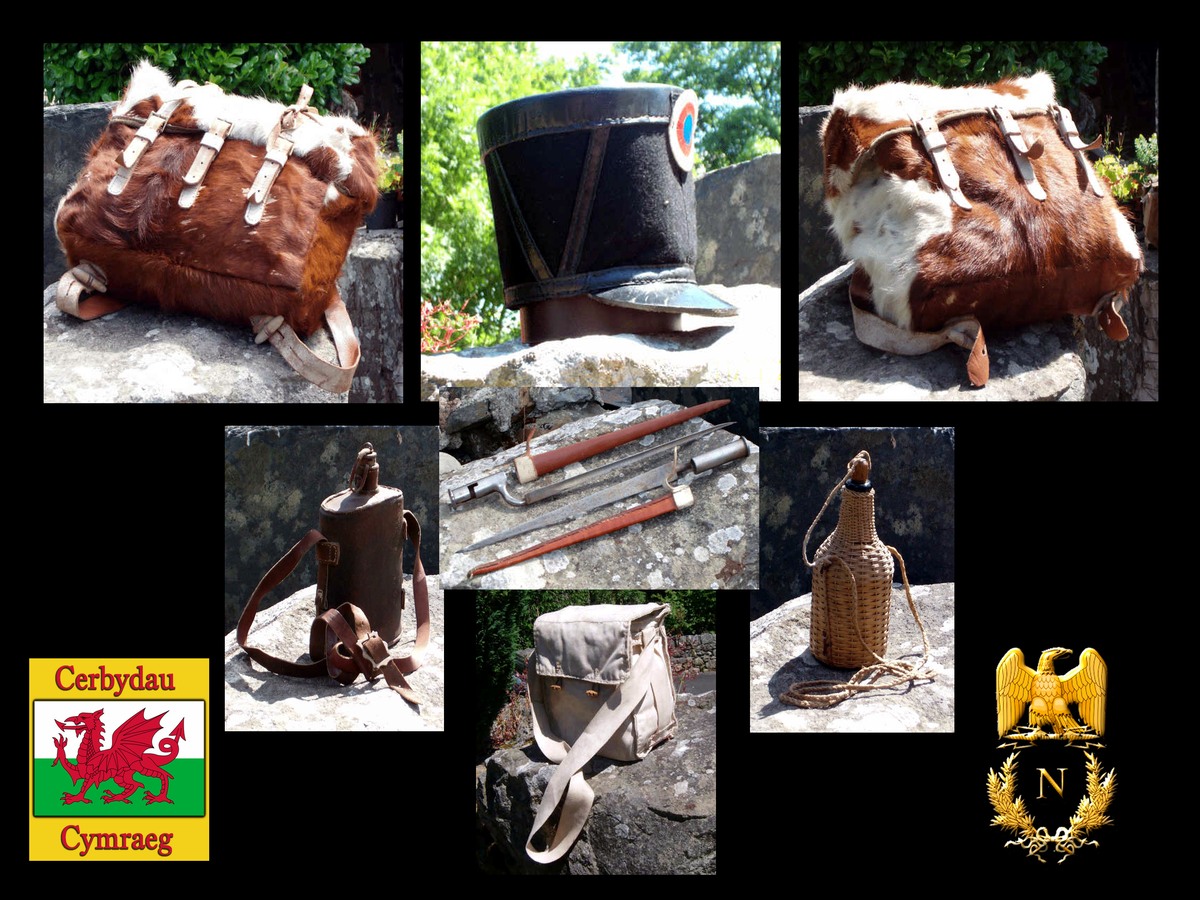
.thumb.jpg.6e903dd66163ad5672f00f144058c571.jpg)
